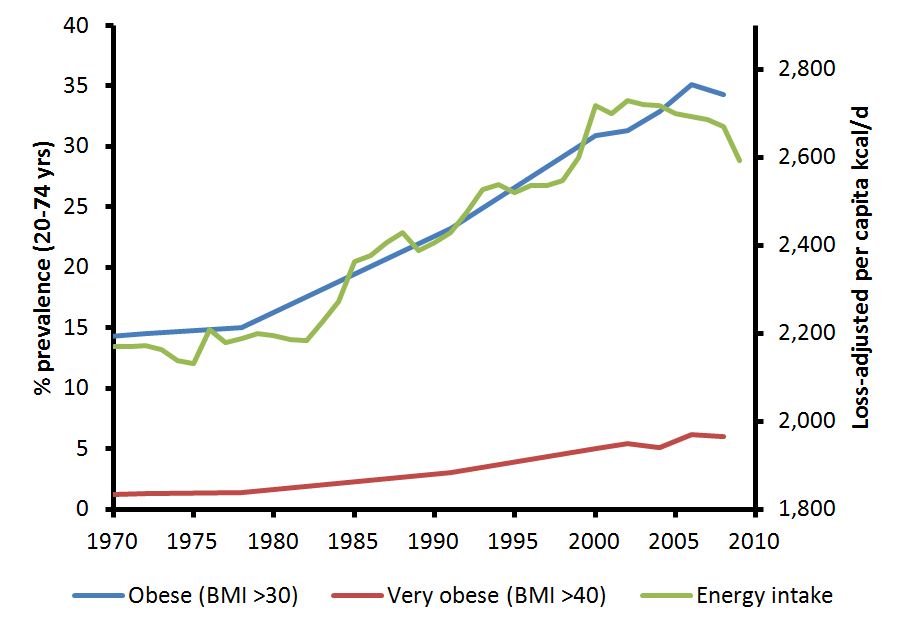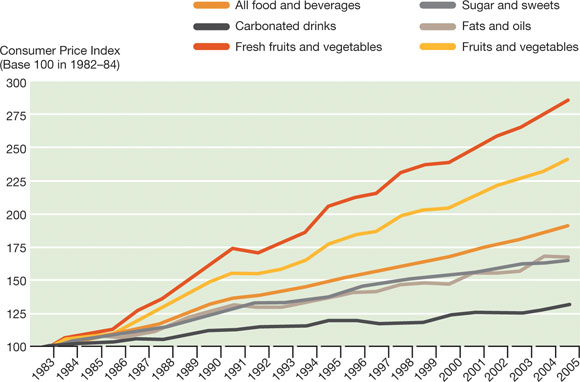1/ #OBESITYSERIES 2: WHY COMMON OBESITY IS NOT A CHOICE
A large number of people, including physicians, believe that obesity is a consequence of a person's moral character or poor choices. The reality could not be farther from the truth. Let's jump in... https://twitter.com/MikeAlbertMD/status/1283553861433581576?s=20
A large number of people, including physicians, believe that obesity is a consequence of a person's moral character or poor choices. The reality could not be farther from the truth. Let's jump in... https://twitter.com/MikeAlbertMD/status/1283553861433581576?s=20
2/ WHY DOES OBESITY OCCUR?
There are many contributors to OB both int. as well as extnl factors. However, the OB epidemic is a relatively new phenomenon that has only been present since the 1970s. Most believe it is due to the convergence of our biology w/ modern food environ.
There are many contributors to OB both int. as well as extnl factors. However, the OB epidemic is a relatively new phenomenon that has only been present since the 1970s. Most believe it is due to the convergence of our biology w/ modern food environ.
3/ We are consuming a lot more food. Our best calculations estimate the modern OB epidemic to be the result of an additional 200 kcal of food per day. H/t @KevinH_PhD and @whsource
4/ So if we are eating more, why don't we just stop? Many have tried. People have been dieting on and off their whole lives, and losing wt and maintaining it is difficult. Anderson et al. 2001 showed that most of the WT lost from diets is regained w/n a few yrs.
5/ Ok, so maybe people are not dieting correctly. Maybe, they eat too many whole-grains and fruit (this one always makes me  ). To understand why people struggle to lose WT, we need to examine their biology through the feedback systems that have evolved to conserve energy.
). To understand why people struggle to lose WT, we need to examine their biology through the feedback systems that have evolved to conserve energy.
 ). To understand why people struggle to lose WT, we need to examine their biology through the feedback systems that have evolved to conserve energy.
). To understand why people struggle to lose WT, we need to examine their biology through the feedback systems that have evolved to conserve energy.
6/ First, let us look at the HOMEOSTATIC SYSTEM. With nerve inputs from many parts of the brain, this system is primarily centered in the hypothalamus and regulates energy expenditure and hunger-satiety. It has developed over millions of yrs to defend against WT Loss.
7/ To understand its development, consider our ancestors. They subsisted as hunter-gatherers, and foraging for food was difficult as the food was not abundant. During times shortage, neural systems developed to  hunger,
hunger,  EE, and
EE, and  motivation-pleasure from energy-dense foods.
motivation-pleasure from energy-dense foods.
 hunger,
hunger,  EE, and
EE, and  motivation-pleasure from energy-dense foods.
motivation-pleasure from energy-dense foods.
8/ This makes sense as our ancestors would have died of starvation and food shortage if they didn't have systems to promote the seeking and storage of energy. The problem is the modern food environment is easy access to hyperpalatable, highly-rewarding, and energy-dense foods.
9/ Back in 1994, a polypeptide was identified that is secreted by fat cells in amts relative to total body fatness. This adipokine, known as leptin, is integral in controlling the homeostatic system. Simply, if one loses WT, leptin  causing activation of hunger centers and
causing activation of hunger centers and  EE.
EE.
 causing activation of hunger centers and
causing activation of hunger centers and  EE.
EE.
10/ Leptin is believed to regulate bodyweight by serving as a trigger for a system w/ thermostat-like regulation of BW. If fat decreases, leptin decreases, and the brain increases hunger and decreases EE in an effort to regain weight around a non-rigid set pt.
11/ Unfortunately, it does not appear that the system is as robust against  in WT, likely attributable to its evolutionary development in a time of food scarcity where WT gain was not the issue. For a review, check out: "Leptin and the maintenance of elevated body weight."
in WT, likely attributable to its evolutionary development in a time of food scarcity where WT gain was not the issue. For a review, check out: "Leptin and the maintenance of elevated body weight."
 in WT, likely attributable to its evolutionary development in a time of food scarcity where WT gain was not the issue. For a review, check out: "Leptin and the maintenance of elevated body weight."
in WT, likely attributable to its evolutionary development in a time of food scarcity where WT gain was not the issue. For a review, check out: "Leptin and the maintenance of elevated body weight."
12/ As for the magnitude of these changes, for every "kg of lost weight, calorie expenditure decreases by about 20–30 kcal/d whereas appetite increases by about 100 kcal/d above the baseline level prior to weight loss." https://www.ncbi.nlm.nih.gov/pmc/articles/PMC5108589/
13/ In summary, the homeostatic system, centered in the hypothalamus, defends changes in BW and will increasingly alter physiology to return bodyweight within a set range, making it difficult to sustain WT loss.
14/ The 2nd major player is the HEDONIC System. This is a complex neural circuit with inputs from all over the brain, which is essential for reinforcement and motivating goal-directed behavior.
15/ Over time, the extnl food cues (advertising), food sensory info (taste/smell), and concentrated ingredients become learned stimuli conditioned by increases in Dopamine to drive eating. Most of these processes occur below conscious control.
16/ Using fMRI, we have been able to show that ppl w OB have  activity of areas of their brain that drive anticipatory feeding but
activity of areas of their brain that drive anticipatory feeding but  in areas of reward. OB drives the WANTING but not contentment, which can lead to overeating as a
in areas of reward. OB drives the WANTING but not contentment, which can lead to overeating as a  stimulus is needed to achieve contentment.
stimulus is needed to achieve contentment.
 activity of areas of their brain that drive anticipatory feeding but
activity of areas of their brain that drive anticipatory feeding but  in areas of reward. OB drives the WANTING but not contentment, which can lead to overeating as a
in areas of reward. OB drives the WANTING but not contentment, which can lead to overeating as a  stimulus is needed to achieve contentment.
stimulus is needed to achieve contentment.
17/ But there are some people who lose weight and keep it off?
You are right! The restrained-eaters are able to engage the 3rd area, the EXECUTIVE SYSTEM (prefrontal cortex). This area of the brain is mostly under conscious control and inhibits Hedonic signaling.
You are right! The restrained-eaters are able to engage the 3rd area, the EXECUTIVE SYSTEM (prefrontal cortex). This area of the brain is mostly under conscious control and inhibits Hedonic signaling.
18/ The executive system is involved in self-regulation and planning. Successful restrained-eaters are able to engage the PFC to emphasize delayed rewards and selective attention. Despite this, the state of OB can blunt PFC activity (image shows  PFC activity for OB person).
PFC activity for OB person).
 PFC activity for OB person).
PFC activity for OB person).
19/ Getting back to our evolutionary perspective, a hedonic inhibitory system may have evolved due to ecological and social pressure, whereby an individual needed to store food for times of shortage, share with a group to cultivate relationships, and take care of offspring.
20/ Research has shown that even successful restrained eaters can be easily disinhibited by acute stressors, which decouple PFC control and leads to overeating. So putting it all together the system looks something like this  (grossly oversimplified).
(grossly oversimplified).
 (grossly oversimplified).
(grossly oversimplified).
21/ The 3 microsystems, which interact with each other and influence the activity of one another are driven by millions of biological factors. The fxn of individual factors is determined by our genetics and epigenetics, which likely explains the variations in Obesity and Wt loss.
22/ Even in the most ideal circumstances, losing WT is hard due to our biology that is maladapted for the modern food environ. Add other ext influences like job-food insecurity, healthy food access, endocrine disrups., environ. toxins, etc. and it becomes increasingly difficult.
You have to understand I simplified what is a complex neuroendocrine system, which science is still elucidating. I believe I made a case for why OB occurs and is much more than a simple choice. As always, I hope you gain some appreciation for ppl struggling w/ this disease. [END]

 Read on Twitter
Read on Twitter











